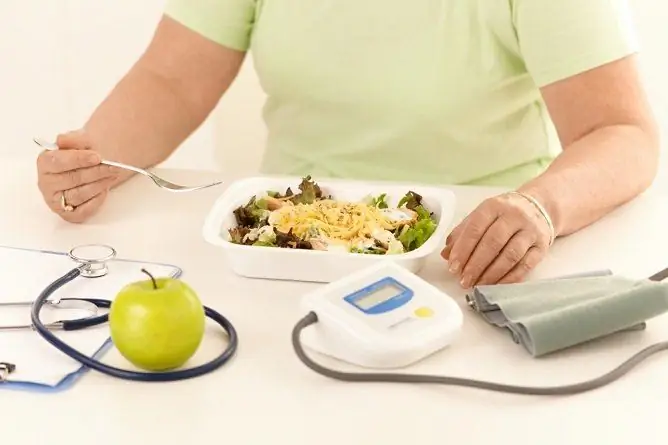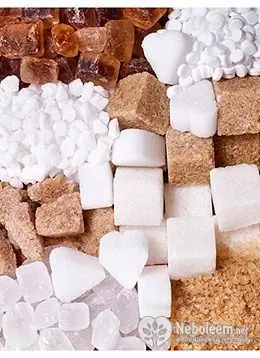- Author Rachel Wainwright [email protected].
- Public 2023-12-15 07:39.
- Last modified 2025-11-02 20:14.
Diet with high blood sugar
The content of the article:
- What to eat with high blood sugar
- What foods should not be eaten with high blood sugar
- Eating with high blood sugar during pregnancy
A diet with high blood sugar is the prevention of the development of diabetes. Against the background of an existing disease, it helps prevent the development of complications.
Hyperglycemia can be a physiological or pathological condition in which a person has an increase in the concentration of glucose in the blood.
Signs of high blood sugar include weakness, rapid fatigability, lethargy, constant thirst, dry mouth, increased urine output, frequent urination (including at night), weight loss with normal appetite, poor healing of superficial injuries, the appearance on the skin of purulent rashes, boils, itching of the skin and mucous membranes, decreased immunity. Also, patients with hyperglycemia often complain of headaches, decreased vision, drowsiness, irritability.

The main method of normalizing high blood sugar is diet therapy.
What to eat with high blood sugar
A diet with high blood sugar involves fractional nutrition (5-6 times a day in small portions), with excess weight, the daily calorie intake should be limited to 250-300 kcal. Overeating should not be allowed. Products are recommended to be boiled, steamed, stewed or baked.
The body's need for carbohydrates (250-300 g per day) should be provided by vegetables, unsweetened fruits, whole grain cereals (buckwheat, oatmeal, less often barley, pearl barley and millet). Cereals are used for cooking cereals, first courses, casseroles. Porridges are boiled in water, milk may be added. Rye or wheat bread made from second grade flour, flour products made from whole grain flour are allowed.

The diet for hyperglycemia should be balanced to provide all the essential nutrients
Legumes can be included in the diet 2-3 times a week. It is recommended to eat fresh vegetables every day, in the form of salads seasoned with vegetable oil, lemon juice, green onions, parsley, dill. Stews or boiled dishes are prepared from white cabbage and cauliflower, broccoli, zucchini, squash, pumpkin and eggplant, tomatoes, onions. It is allowed to eat garlic, spinach, celery. Soy products are allowed in small quantities. Potatoes, beets, boiled peas, carrots should be included in the diet no more than 3 times a week. The use of blueberries, blueberries, cranberries, apples, watermelons, grapefruits is allowed.
The diet should contain a physiological amount of protein. Preference should be given to the following protein products:
- dairy products of low fat content (kefir, natural yogurt without additives, low-fat cottage cheese, yogurt, cheese);
- eggs and egg white (no more than three per week);
- fish (pollock, cod, perch, pike, pike perch);
- seafood (mussels, scallops, shrimps, octopus, squid).
It is allowed to eat soaked herring once a week. Kefir or natural yogurt is recommended in the amount of two glasses a day. Meat should be selected from low-fat varieties. People with hyperglycemia should eat beef, veal, pork and lamb without fat, chicken and turkey without skin. It is allowed to eat a rabbit, diet sausage, boiled tongue. Elderly patients with high blood glucose levels are advised to reduce the amount of meat in the diet, giving preference to fish.
Fats, half of which should be vegetable oils, are limited to 60 g per day. Cream or sour cream (no more than 10% fat) can be added to ready-made meals (no more than one tablespoon). The use of butter is limited to 20 g per day, it should be added to ready-made meals. Salads are seasoned with vegetable oil; it can also be used in the preparation of first courses.

When following a diet to lower blood sugar, choose vegetable oils over animal fats
First courses should consist mainly of cereals and vegetables, and may be dairy. Patients with hyperglycemia can cook soup, cabbage soup, borscht, beetroot on bran broth. Soup with meat or fish broth is allowed once every ten days. Okroshka is allowed on whey or kefir.
From spices for hyperglycemia, you can use cinnamon, turmeric, saffron, ginger, vanillin, you should limit the use of mustard and horseradish. It is permissible to add apple cider vinegar to food. Sauces can be cooked with vegetable broth or milk.
Sweeteners can serve as a substitute for sugar, which are natural (stevia, fructose, xylitol, sorbitol) and synthetic (saccharin, aspartame, sucralose), while the latter are recommended to be consumed in small quantities. The daily dose of xylitol should not exceed 35 g, otherwise intestinal disturbances are possible. Fructose should also be used only in limited quantities as a sugar substitute.
Biscuits and sweets with fructose or xylitol are allowed, and small amounts of honey are allowed. Fruit can be used to make jelly (preferably on agar-agar), mousses, compote.
Patients with hyperglycemia are allowed vegetable, berry and unsweetened fruit juices, chicory, rosehip decoction, weak tea, natural black coffee or with the addition of milk, mineral water. The daily amount of water should be 1.2-1.5 liters.

The drinking regime should be observed, drinking about 1.4 liters of water daily
In the case of high blood pressure and cardiac abnormalities against the background of hyperglycemia, table salt should be excluded from the diet. For all other patients with high blood sugar, a daily intake of no more than 4 g of salt is permissible.
With hyperglycemia and concomitant hypercholesterolemia, to lower cholesterol levels, foods that have a lipotropic effect should be included in the diet. For this purpose, vegetable oils (olive, corn, linseed), beef, tofu, and fiber-rich foods are recommended. Iodine contributes to the improvement of fat metabolism, for this reason it is advisable to include kelp in the diet. Dried seaweed can be ground in a coffee grinder and used as salt. It is recommended to include bran in the diet, which can be poured with boiling water, and then mixed with yogurt, kefir, cottage cheese or juice. Bran broth can be used to make drinks and soups.
Patients with hyperglycemia should limit the intake of simple carbohydrates, ensure sufficient fortification of food, adherence to the diet. In the process of developing a diet with high blood sugar, the patient's body weight, the presence of individual intolerance to certain foods, obesity, concomitant diseases, as well as blood glucose levels are taken into account. In case of hyperglycemia, it is recommended to develop a menu for the week ahead of the permitted food.
What foods should not be eaten with high blood sugar
A diet with high blood sugar requires exclusion from the diet of alcoholic beverages, fatty meats, fish, offal (heart, liver, kidneys, lungs, brain), smoked meat and fish products, canned food, meat sauces, pork, beef or lamb fat, caviar.
Spicy and salty hard cheeses with a fat content of more than 40%, fatty sour cream and cream, long-term storage yoghurts with added sugar and / or fruits, cottage cheese desserts are undesirable. Bananas, pineapples, dates, figs, grapes and raisins, jam, ice cream, cocoa and chocolate, packaged juices, sweet non-alcoholic carbonated drinks, as well as pasta, semolina, rice are excluded from the diet.

With hyperglycemia, sweets and confectionery must be discarded.
It is necessary to completely abandon the use of sugar and premium flour, as well as products containing them. Spicy sauces, margarine, pickled and fried foods with high blood sugar should also be excluded from the menu.
Eating with high blood sugar during pregnancy
Fractional meals are also recommended for pregnant women with hyperglycemia - food should be taken in small portions every three hours, with a night gap of no more than 10 hours. Milk and fruit should not be consumed at night.
High-fiber foods are recommended for breakfast, including biscuits.
Lean meats should be preferred, trying to remove all visible fat as much as possible. Chicken soups are acceptable; the diet should include raw vegetables (including vegetable salads), berries and unsweetened fruits.

Pregnant women with hyperglycemia need to eat a diet to prevent gestational diabetes.
Mushrooms, red meat and spicy foods are not recommended. Cream cheese, margarine, sauces are excluded. Food should not contain a lot of salt and oil.
With an increased concentration of glucose in the blood, pregnant women need to drink at least 1-1.5 liters of water per day.
To normalize glucose levels, in addition to diet, it is recommended to do physical therapy exercises daily.
YouTube video related to the article:

Anna Aksenova Medical journalist About the author
Education: 2004-2007 "First Kiev Medical College" specialty "Laboratory Diagnostics".
Found a mistake in the text? Select it and press Ctrl + Enter.






